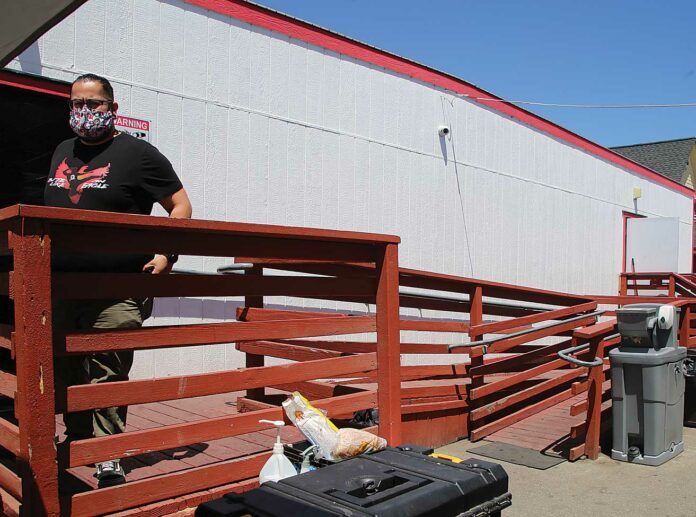
For years, the Salvation Army in Watsonville has provided temporary shelter for homeless people, in addition to services such as showers, clothing, mail, lockers and laundry at the organization’s Navigation Center. This includes roughly 120 dinners per day, as well as a light breakfast.
“Sometimes this is the only meal they get,” says Shelter Manager Cesar Leon.
Those services have been possible thanks to $830,000 in annual funding from the County of Santa Cruz, which comes in part from one-time state block grants.
But that money is now being reallocated to a new homeless housing project, which Salvation Army officials say could mean the closure of its 24-bed shelter, and an end to the services for the people who stay there.
Santa Cruz County spokesman Jason Hoppin says that the funding will go to a community of tiny homes, a joint project between the counties of Monterey and Santa Cruz, the city of Watsonville and Pajaro Regional Flood Management Agency. It is made possible by $8 million in state Encampment Resolution Funding announced in June.
That project, which will initially include 34 tiny homes, has been tentatively slated for the parking lot of Westview Presbyterian Church at 118 First St. in Watsonville. The City Council will discuss the project at an upcoming meeting.
But that site at first will only be for the homeless people living along the Pajaro River Levee, and with funding for the Salvation Army’s shelter ending on March 31 of next year, the people who use the shelter—more than 17,000 last year—will be left in the lurch, says Salvation Army Board Chair Trina Coffman-Gomez.
“Where are they going to go,” she says. “We don’t know where there will be a shelter for the clients that we’re currently serving, and there is a waitlist to that as well. We don’t need to shut something down that is working and functioning.”
The organization has been asking for a two-year extension to allow officials to seek funding to replace its aging modular residential structure, which was placed there in response to the 1989 Loma Prieta Earthquake. But city and county officials have rejected that request. Now, the organization has four months to develop an exit strategy, Coffman-Gomez says.
“I’m not saying the (tiny homes) project shouldn’t take place,” she says. “I’m saying it shouldn’t shut down another project when we need more help than just specifically the levee residents. My biggest concern is that we are focusing on a specific segment of the population while leaving a greater majority of people that will be left to roam the streets because the county is no longer providing funding for services.”
The county’s plan
Santa Cruz County Housing for Health Director Robert Ratner says that the project meets state regulations for “low-barrier” shelter programs, and will offer private accommodations with their partners and pets. That’s contrasted by “high-barrier” requirements of other shelters such as curfews and lights-out times.
Leon says that those rules are meant to instill a sense of order in the lives of the residents, many of whom are battling addiction.
“We’re obviously trying to get people housed, and in order to get people housed you have to build structure,” he says. “The way we implement structure is by setting these rules.”
Plans for expansion
While initially serving people living along the levee during the two-year life of the grant, the project will expand to other residents, and will continue using the funds that were formerly allocated to the Salvation Army, Ratner says.
With some 200 people in Watsonville experiencing homelessness on any night, there is not enough funding to support two shelter sites in Watsonville, Ratner says.
“The new site will be structured to ensure it meets new standards for shelter operations and thus future funding and it will also include the potential for partnerships and future funding linked to Medi-Cal,” he said.
Lt. Nayeli Mercado, who manages the facility at 214 Union St., says the shelter program has a list of 300 people who utilize the services, with roughly 50 people per day stopping by.
Mercado says the Salvation Army has no plans to cease its services entirely. The organization will continue to provide services for low-income people such as a food pantry and a daily meal, she says.
“The Salvation Army was here for a long time, and its only purpose is to serve the community in different areas,” she says.












Sol, by cutting funding to Salvation Army which does a wonderful job, there will be more homeless and hungry people. Not a good idea. Also why is Watsonville the place to dump tiny homes because you know this will become another drug area with the homes destroyed. Most homeless are meth heads who would rather use drugs than work and support themselves. The halfway house on Madison St in Watsonville was destroyed by the druggies and still hasn’t been repaired by the owner, Mr Allen. Leaving this property as it is, destroys home values in the area. Druggies don’t do anything but steal to support their habit and destroy property.
So sorry to hear this news about the Salvation Army. They offer incredible selfless service to those hurting and lost and to our community as a whole. We really need to support them.